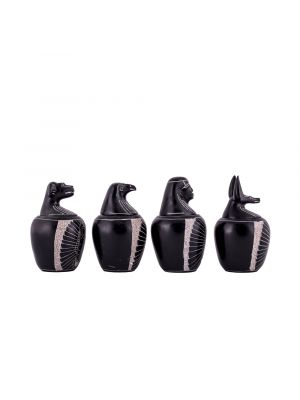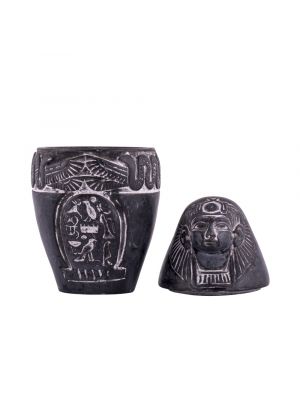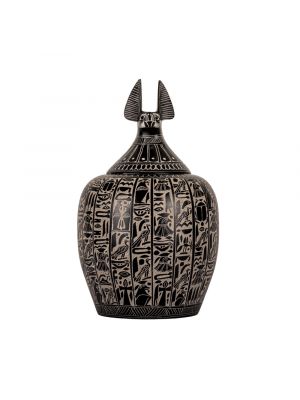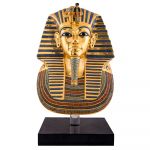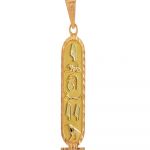Canopic Jars
Canopic Jars
Story About Canopic Jars
Canopic jars were used by the Ancient Egyptians during the mummification process to store and preserve the viscera of their owner for the afterlife. These would then be placed alongside the sarcophagus or coffin in their tomb or burial site. Additionally, they would sometimes also contain the ashes of a favored pet or animal of the deceased.
A set of four canopic jars was a significant burial element across almost all periods of ancient Egyptian history. Canopic jars were containers used to contain the mummified organs of the deceased. The most well-known versions of these canopic jars are fashioned with lids in the shape of the heads of protective deities known as the four Sons of Horus. The human-headed deity was called Imsety was the guardian of the liver. The baboon-headed Hapy was tasked with protecting the lungs. Duamutef, depicted with a jackal-head was responsible for the stomach. Lastly, the falcon-headed Qebehsenuef took care of the intestines.
When mummification was still in its infancy during the Old Kingdom, the canopic jars that served a funerary purpose were simple stone vessels, with a plain lid. The canopic jar became more sophisticated and held significant spiritual importance. The emergence of canopic jars fashioned with human-headed lids was not until the First Intermediate Period. The image during this time period was most likely of the dead person rather than the protective deities. Also around this time, arose another peculiar practice. The packages of viscera placed inside the jars were sometimes decorated with human-faced masks. From the nineteenth dynasty going forward, the lids of the jars were each shaped like the head of one of the four minor funerary deities, known was the “four sons of Horus”.
Towards the end of the New Kingdom, the process of removing the viscera and placing it in canopic jars began to die out. The mummies began to have their organs returned to the body cavity after the embalming process. However, the canopic jar had become a fundamental part of the funerary process, engrained into the traditions of funerary practices. Thus, some of the nobility or high-ranking officials were given empty jars – or even some containing imitation organs inside. By the late Third Intermediate Period these symbolic canopic jars were eventually replaced with solid dummies with the form of the canopic jar overshadowing the purpose. Thus, in their final form, canopic jars were simply a symbolic representation of a long-past ancient funerary practice. The canopic jars we offer mimic canopic jars from the New Kingdom because they were more decorative and ornate.
Our Divine Four Sons of Horus Basalt Set of 4 Canopic Jars follows in the tradition of ancient Egyptian funeral practices with each of the canopic jars representing one of the protective deities, the Four Sons of Horus – Hapy, Imsety, Duamutef, and Qebehsenuef. Each of them is responsible for guarding the mummified internal organs for the afterlife.
This unique set of carefully-engraved and hand-painted canopic jars is made with the finest, most durable basalt stone. Each jar is embellished with different intricate ancient Egyptian hieroglyphics and motifs that were commonly found on canopic jars from the New Kingdom.
While this item is a general storage object, it is the perfect urn to store and memorialize the ashes of a favorite pet, so they can remain close to you and your family. This jar has a large opening to make it easy to deposit any remains and can be easily sealed with silicone adhesive gel or strong glue to make sure it remains safe and sealed. The lid is removable (in keeping with how they were traditionally made in ancient Egypt) and is polished with a thin layer of wax for protection.
One of our most unique historically-accurate items is our Anubis Alabaster Funerary with Four Canopic Jars and Anubis Figurine. This beautifully hand-crafted, high-quality replica of an Anubis Funerary Urn dating back to 3500 years ago is a marvelous relic. This stunning funerary urn is adorned with accents of blue, hieroglyphic inscriptions and a sacred scarab beetle.
It comes with a jackal-headed Anubis statue God Anubis statue, intended to be placed on top of the urn for protection as the ancient Egyptians would have done. It also comes with the four classic canopic jars, where the organs (liver, lungs, stomach, and intestine) were placed before mummification in ancient Egyptian funerary practices. These carefully-engraved and premium sculpted funerary urn, canopic jars and Anubis figurine are made with authentic Egyptian alabaster.
A fundamental religious belief held by the ancient Egyptians was that life on earth was only the first part of their journey in this world. They did not believe in death, per say. Death was considered a transition into the afterlife or another realm of eternal paradise, the Field of Reeds or Field of Offerings, A’aru. This was considered a reflection of one’s life on earth. Essentially, the goal was to make life on earth worth living eternally.
Their perception of death was solely influenced by their firm belief in immortality. To ensure the continuance of life after death, the ancient Egyptians paid homage and made offering to the gods and deities known as the Seven Hathors.
Upon death, the ancient Egyptians believed one had to be mummified in order for his soul to return to the body and continue on the eternal journey to the promised afterworld. Through mummification, the corpse would be transformed into a new body, destined to live and rise again. The preservation of the corpse was vital because the ancient Egyptians believed that the soul and personality of the dead continued to live in the body even after death. Without the body, the soul no longer existed.
Upon the death of kings, the process of mummification quickly begins. All internal organs were remove through an incision on the left side of the body. It was critical that the incision was expertly cut, without causing major damage to body or the internal organs. Once the organs were removed, they were places in the appropriate canopic jars for protection.



